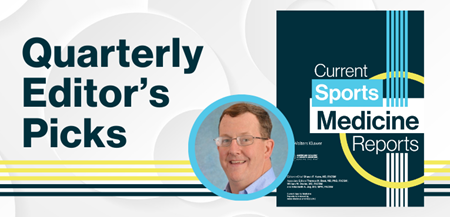Shawn F. Kane, M.D., FACSM |
Jan.
9, 2024
 One of the best parts of Current Sports Medicine Reports (CSMR) are the interesting and educational case reports that are submitted. They are informative and highlight interesting clinical cases that help to increase our knowledge base and remind us to maintain a high degree of clinical suspicion and to keep searching for answers when things just don’t add up like they should.
One of the best parts of Current Sports Medicine Reports (CSMR) are the interesting and educational case reports that are submitted. They are informative and highlight interesting clinical cases that help to increase our knowledge base and remind us to maintain a high degree of clinical suspicion and to keep searching for answers when things just don’t add up like they should.
I would like to highlight three not-to-be-missed cases from the past quarter:
Blunt Ocular Trauma in Sport submitted by Daniel, et al. is an interesting (and must say scary) case of traumatic vision loss while playing soccer. Player sustained trauma to the eye from a kicked ball and had 30 minutes of monocular blindness prior to seeking medical care. The player was appropriately diagnosed and treated for traumatic iritis and commotio retinae and was able to return to play with complete resolution of symptoms. The authors of this interesting case report go on to discuss what is needed for a timely and thorough sideline assessment as well as the differential diagnosis for ocular trauma.
Popping Pimples or Bones? A Clinical Vignette of a Lacrosse Player on Isotretinoin with Multifocal Lower-Extremity Bone Stress Injuries submitted by D’Amico and Schroeder. This case to me highlights the importance of taking a good history, doing a thorough medication reconciliation, and searching for answers when things do not add up. I am sure many of us have a lot of patients taking isotretinoin for acne and if they have a bone stress injury would you think about stopping the use of isotretinoin?
Platelet-rich Plasma (PRP) Treatment of a Quadriceps Tendon Tear in a Collegiate Basketball Athlete submitted by Lutz, et al. is an interesting case using PRP to treat a quadriceps tear. Extrapolating data from the treatment of patellar tendon injuries the authors used PRP as well as traditional rehabilitation to treat the injury and return to athlete to sport. One highlight that is important for this case is the authors thoroughly and objectively describe the components of their PRP injection and rehabilitation program, so that others can replicate it.
We also have awesome articles that cover a variety of areas, and I would like to highlight three from the past quarter:
Assessment of the Current State of Sports Coverage Participation, Training, and Confidence Ratings among PMR Residents and Residency Programs submitted by Stokes, et al. This is an article in our Clinical Curriculum Series, and it shows that exposure to sports medicine during training leads to confidence. While completed with PMR residencies, I am pretty sure this would be similar amongst all Sports Medicine disciplines. Hopefully, this information can help other programs dedicate time to sports medicine interests.
Clinical Considerations in Returning Pediatric and Young Adults with Cancer to Physical Activity submitted by Dykowski, et al. We know that physical activity is beneficial and can be an adjunct treatment for many conditions. When and how to get patients with cancer diagnoses back to physical activity can be challenging due multiple variables. The authors of this paper do to an excellent job at providing some guidance on clinical considerations when contemplating a return to activity. As we continue to improve cancer treatments, getting patients exercising will be good for their physical and mental health.
Lastly, as we continue to address the conditions of pediatric obesity and inactivity, I would like to highlight the article May the Force Be with Youth: Foundational Strength for Lifelong Development submitted by Faigenbaum, et al. I would suggest that every Primary Care Sports Medicine provider read this and share it with their Primary Care Colleagues. This article provides excellent information on not only the why this concept is important but also provides some excellent information on how to address it. This is crucial for the long-term health, wellness, and safety of our nation.
CSMR is ACSM’s official monthly clinical-review e-journal. Written specifically for physician and clinician members, CSMR articles provide thorough overviews of the most current sports medicine literature. ACSM physician members receive an online subscription to this journal as a member benefit.
 Shawn F. Kane, MD, FACSM is a family physician, associate professor in the Department of Family Medicine, and adjunct assistant professor in the Department of Exercise and Sports Science at the University of North Carolina (UNC) Chapel Hill. He received his medical degree from the Uniformed Services University of the Health Sciences and served in the U.S. Army for 27 years. While in the Army he spent more than 18 years serving as a physician-leader in numerous units within the US Army Special Operations Command. He is interested in sports medicine, concussion care, veterans’ health, and primary care of patients with post-traumatic stress disorder. Dr. Kane joined ACSM in 2003 and became a fellow in 2011. He currently serves as the editor-in-chief for Current Sports Medicine Reports, on ACSM’s Clinical Sports Medicine Leadership Committee, ACSM’s Health & Fitness Summit Program Committee, and ACSM’s Program Committee. Outside of the office, Dr. Kane enjoys hanging out with his Leonbergers (big furry, cute German Mountain dogs), as well as working out and traveling.
Shawn F. Kane, MD, FACSM is a family physician, associate professor in the Department of Family Medicine, and adjunct assistant professor in the Department of Exercise and Sports Science at the University of North Carolina (UNC) Chapel Hill. He received his medical degree from the Uniformed Services University of the Health Sciences and served in the U.S. Army for 27 years. While in the Army he spent more than 18 years serving as a physician-leader in numerous units within the US Army Special Operations Command. He is interested in sports medicine, concussion care, veterans’ health, and primary care of patients with post-traumatic stress disorder. Dr. Kane joined ACSM in 2003 and became a fellow in 2011. He currently serves as the editor-in-chief for Current Sports Medicine Reports, on ACSM’s Clinical Sports Medicine Leadership Committee, ACSM’s Health & Fitness Summit Program Committee, and ACSM’s Program Committee. Outside of the office, Dr. Kane enjoys hanging out with his Leonbergers (big furry, cute German Mountain dogs), as well as working out and traveling.